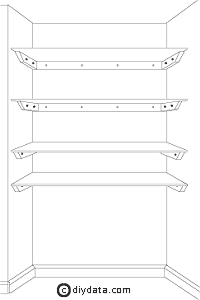Shelving - the different options
Every home needs some form of shelving, whether it is in the kitchen, bedroom or workshop. There is a wide range of options to choose from when deciding what type of mountings to use and what type of material to use for the shelf.
Before deciding what 'system' to use and the type of material for the shelves, you need to consider what you will be storing on them and how you want the look of the shelving to fit in with you decor.
The weight of what you want to put on the shelf will affect the shelving material, its thickness and the distance between the supports - our page on Shelving materials gives guidelines.
The shelving 'systems' available can be categorised simply as:
- Fixed brackets - individual brackets are secured to the vertical wall and the shelving is laid across them.
- Built in shelving - where an existing alcove (such as by the side of a chimney breast) is shelved with supports screwed to the sides of the alcove.
- Adjustable Slotted Shelving Systems using vertical rails into which the brackets can be inserted at different heights.
Before putting up any shelving, it is worth considering the faults associated with shelving failing as described below, then you will know what not to do.
The method used to fix the shelving to the wall will depend on the type of wall in question, walls will commonly be brick or block covered in plaster, plasterboard or lathe and plaster studding, or, brick or block dry lined with plasterboard. See our page for how to make strong fixings to each wall types for details of actual wall fixing methods.
Individual brackets.
 Individual shelf brackets are available in a wide range of shapes and sizes to suit most requirements. They range from simple, plain brackets to highly decorative ones in all types of finishes and colours.
Individual shelf brackets are available in a wide range of shapes and sizes to suit most requirements. They range from simple, plain brackets to highly decorative ones in all types of finishes and colours.
Most brackets are uneven i.e. the lengths of the two arms which make up the 'L' shape are different lengths. The shorter arm is normally designed to fit under the shelf, while the longer arm fits against the wall - this reduces the leverage of the bracket from the wall. The width of the shelf should only be slightly wider than the shorter arm of the bracket.
Brackets can be fixed directly onto a masonry wall using appropriate wall plugs. Alternatively first fix vertical wooden battens to the wall and then screw the brackets to the the battens.
See our pages for fitting shelves with bracket:
- Short shelves - where the brackets are fitted to the shelf before fixing to a wall.
- Long shelves - where the brackets are fixed to the wall first.
Built in shelving
 One of the simplest forms of shelving is the built-in type where an existing alcove (such as by the side of a chimney breast) can be shelved with supports screwed to the walls at the sides. This often uses a space which would otherwise be wasted.
One of the simplest forms of shelving is the built-in type where an existing alcove (such as by the side of a chimney breast) can be shelved with supports screwed to the walls at the sides. This often uses a space which would otherwise be wasted.
Although limited by the width, these shelves can be quite flexible:
- Different heights and depths of shelving can be used, they don't all need to be the same.
- Space can be left for a piece of furniture sitting on the floor.
See our page on fitting shelving in an alcove.
Adjustable Slotted Shelving Systems
 Adjustable slotted shelving systems are readily available, all you need do is to fix the vertical rails to a wall and the brackets to support the shelves just slot in to them.
Adjustable slotted shelving systems are readily available, all you need do is to fix the vertical rails to a wall and the brackets to support the shelves just slot in to them.
The systems consists of two main parts:
- The vertical rails which are secured to the wall - these have some form of location for the brackets - often slots.
- The shelf brackets which just slot or clip into the vertical rails.
The design and fit of the vertical rails and brackets vary between systems and manufacturers and are not usually interchangeable.
The rails and brackets are usually either steel or aluminium and are available in different sizes to suit the height and width of shelving required.
These systems are a simple method of shelving that is easy to fit to provide neat, robust and easy to adjust shelving.
Shelving faults
No matter which type of shelving is used, they tend to fail because of one of these factors:
- Brackets bending - choose the correct brackets for the weight to be supported.
- The fixing screws pulling out of the wall - the screws may be too short, incorrect wall plugs used or not installed appropriately for the type of wall. See our page for how to make strong fixings to different types of wall.
- Sagging of the shelf - usually caused by the supports being too far apart: the load on the shelf, the material and its thickness all affect the maximum distance between brackets.
- Breaking of the shelving material usually following sagging - the causes are the same as for sagging, just more so.
